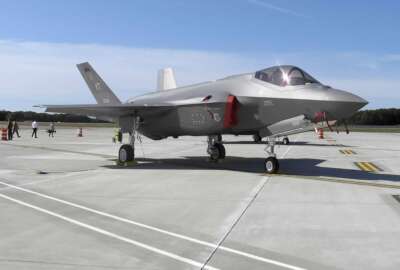
For fiscal 2023, the Pentagon’s troubled relationship with a troubled airplane flies on
The F-35 has become synonymous with all of the problems the 21st century Pentagon deals with. For fiscal 2023, the topline budget calls for buying only 61 new...
Best listening experience is on Chrome, Firefox or Safari. Subscribe to Federal Drive’s daily audio interviews on Apple Podcasts or PodcastOne.
The F-35 has become synonymous with all of the problems the 21st century Pentagon deals with. For fiscal 2023, the topline budget calls for buying only 61 new copies instead of the 94 originally planned for. The stealth aircraft continues to have problems with performance and sustainability. Joining the Federal Drive with Tom Temin with some new problems, long-time critic and fellow at the Project on Government Oversight, Dan Grazier.
Interview transcript:
Tom Temin: Dan, good to have you back.
Dan Grazier: Hey, Tom, thanks for having me.
Tom Temin: This plane has been in development, well, really for a generation of warfighters. Is this normal this length of development and deployment cycle?
Dan Grazier: It’s absolutely not. The development length of the F-35 is really is truly unprecedented for aircraft. I mean, we’ve had entire fleets of of aircraft that have gone from the drawing board through deployment through retirement in less time than the F-35 has been developed.
Tom Temin: Wow. All right. So the latest is you have obtained a report that the Pentagon did not classify, but actually did not publish either that details an astonishing list of issues with this plane, give us the highlights here.
Dan Grazier: Right. So it was kind of an unprecedented move from the Director of Operational Test and Evaluation to produce three versions of the report this year instead of the two that are mandated by federal law. And the one that has traditionally been made public this year was stamped, controlled unclassified information and withheld from the public, but I was able to get a copy of it. And, and really, what it shows is that the program is still not ready for primetime, really, they’re still dealing with all kinds of issues as far as reliability goes. They still haven’t fixed all the cyber vulnerabilities that have been known about for years and has still not been corrected. It also shows that the program’s very clunky logistics and maintenance network, that’s all encompassing information system for the F-35, the the original one, the autonomic logistics information system was scrapped about two years ago, it to be replaced with with a new system. But the new system is still carrying a lot of the problems that the ALIS had, and has already fallen behind schedule. So the F-35 program is still a long way from from being ready to go.
Tom Temin: So the result is that the readiness of the fleet that they do have is something like 60%, and that’s below their target of 65% of the planes ready to go at any moment. And they found something close to 1,000 defects in the plane. And six of those are considered category one, that report said, What does that mean?
Dan Grazier: So there’s really like two basic kinds of design flaws, or depending on causing deficiencies. So the category one is the most serious, those are the ones that could lead to a mission failure, or even a danger to life or limb for the pilots. And so the program has dealt with a lot of those over the years. And in this current report, it listed 845 total design flaws, which is down a little bit from last year. Last year, it was 871. But the problem with that is that as testing goes on, the testing officials continue to find new design flaws almost as fast as they are able to clear out the old ones. And so it’s just this it’s one step forward three quarters of a step back process that has been going on for years.
Tom Temin: We’re speaking with Dan Grazier, military fellow with the Project on Government Oversight. And what does the report say the Pentagon plans to do next here? What’s their strategy for this?
Dan Grazier: Well, so moving forward, the program kind of stagnated in 2022, or I’m sorry, in 2021, because they cannot get the joint simulation environment. It’s this really high fidelity simulation facility down in Patuxent River, Maryland, where they’re supposed to test the really high end capabilities of the F-35. You know, there’s capabilities of being able to fly directly over the near pure enemy capital and perform missions. You know, it’s that those high end capabilities for which we’re paying a premium for the F-35. But they can’t test those in open air ranges. So they need the simulator to be able to do that. And the simulator has been in development since 2015. And it is still at least a year away from being ready to go for these final tests. So what that does, that really kind of keeps the program in a, in kind of suspended animation as far as development goes. So they can’t cross that final hurdle that they need to to move into full reproduction.
Tom Temin: Now the Pentagon does have, the different armed services do have a couple of hundred of these things and I think Germany said it would just buy another 35 of them of the F-35. So they do have an engine they do get out off the ground and fly. And there have been some European sorties with them patrolling or so. So what can they do, because it sounds like they’re partially in service?
Dan Grazier: They are partially in service. And, and the services were kind of, were kind of quick to push them into active service, there was a couple of F-35 missions over Afghanistan a couple years ago. And, you know, the Israelis have used theirs a couple of times, according to some of the publicly available reports.
Like it can fly, sometimes it can perform some of its missions, but it certainly cannot fly often enough to be really operationally effective, and it still can’t perform those higher end missions that are the big selling point for the F-35.
Tom Temin: All right. And so then, what about Lockheed, there have been program managers for the F-35, that have really held Lockheed’s feet to the fire on this. And that kind of goes back and forth. What’s the status of the relationship between the Pentagon or the F-35 Program Office and and the prime contractor these days?
Dan Grazier: Well, we’ve gotten various public reports over the years, sometimes it’s reported from government officials that the relationship is good. Sometimes, they kind of struggle, they it seems, largely, the biggest bones of contention are the long term sustainment contracts for the F-35s. There’s plenty of people in the government. While Congress is asking a lot of questions about the long range affordability of the program. And that’s, like the sticker price of the F-35 garners a lot of attention. But the real cost of the program is the long term sustainment costs. And because the F-35 was built, it was designed largely to be a revenue generator for Lockheed Martin, because only Lockheed Martin can perform a lot of the basic maintenance functions of the F-35. It’s going to have a high operating cost, because it was designed that way. And, you know, so that’s giving people in government a lot of heartburn, because they know that it’s going to be really difficult to afford the program at the numbers that are currently planned.
Tom Temin: So it’s a high sustainability cost for the government. But an annuity, so to speak for Lockheed?
Dan Grazier: Right, yeah, it’s a guaranteed revenue stream as long for Lockheed Martin, as long as the F-35 is in service. And that goes all the way back to the original contract, which allowed Lockheed Martin to retain control of all the intellectual property and data rights to the program. So the government has no choice but to go to Lockheed Martin for these long term sustainment contracts, because they don’t own the data, right. So they can’t issue a competitive bid proposal for other people that come in and do the same job. And an even better course of action would be for uniformed service members to perform these functions, which is the way things should be. But that was not the strategy that was pursued in this instance.
Tom Temin: And in buying only 61 instead of 94. Why buy any until, say they get it down to 500 defects instead of 845?
Dan Grazier: Right. Well, I the official sticking point for the larger buy this year was the fact that the the F-35 is not fully developed. Right now the program is in block four or modernization. And I always use the finger quotes when I say modernization, because really what that is that the program ran ran out of time and money to complete development of the program. And so instead of asking for more time, and more money as part of the original development process, they just shunted a lot of that work over into the modernization phase. And so the Block IV capabilities are what is supposed to be the F-35. What was, what is promised all these years, and that’s just not ready. And it’s a couple of years before that’s going to be completed. And so the idea behind reducing the annual buy this year was that the services didn’t want to buy a bunch of underdeveloped aircraft that are going to require expensive and extensive modernization for retrofits down the road.
Tom Temin: Dan Grazieris military fellow with the Project on Government Oversight. As always, thanks so much.
Dan Grazier: Hey, thank you very much, Tom. It’s a pleasure to be here.
Copyright © 2025 Federal News Network. All rights reserved. This website is not intended for users located within the European Economic Area.
Tom Temin is host of the Federal Drive and has been providing insight on federal technology and management issues for more than 30 years.
Follow @tteminWFED






